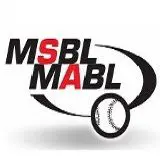For the Love of the Game: One Amateur Baseball Player’s Journey to Throw with His Opposite Arm
Compiled by Steve LaMontia, Director of Communications
My name is listed above not for any particular work I did to put this wonderful piece together, but because I need to explain what you are about to get into.

This story was painstakingly and professionally constructed by Shawn Lee, League President of the 26-team-four division North Texas Amateur Baseball League located in and around Dallas. Shawn is also the manager of the Dallas Spirits, who play in his 42-over division. Why is this important? Because Eric McPherson plays on his team, in his league, and his remarkable story is conveyed below by Shawn. Eric is the subject of this story.
Here is where I come in. I am merely a means of introducing the main players in this gem. This is a story about a right-hander who turned into a left-hander when he got a bum shoulder and is now thriving once again in the league. His journey is amazing. But I have a spoiler alert: this story is way, way too long and through my journalistic expertise, a reader tends to quit reading after about a fourth of a story this length is absorbed. My advice is to keep reading. Grab your favorite beverage, sit down, and read it all. Eric just may become your role model.
I won’t go any further with the introduction. Shawn did a magnificent job with this story and I applaud him for it. The real shining star here is Eric. You’ll soon learn why.
(May 15, 2023 – Story by Shawn Lee)
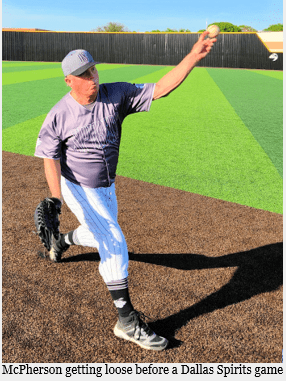
How many of you have tried to throw with your opposite arm? You likely tried this maneuver several times as a kid or even later when you were playing as a teen. As ballplayers, we all mess with the idea or joke around trying to make that throw with the opposite arm or to mock our teammates who use an arm different from ours. In my experience, it’s often right-handers trying to throw left-handed. Often funny, and typically accompanied by the outdated or sexist remark, “You throw like a girl,” most of us are not very comfortable nor successful in throwing a baseball oppo.
But what if you had to learn how to throw with your opposite arm? Could you do it? Could you actually get back onto the field and be effective in throwing a baseball with your opposite arm? It is likely there are folks out there that may have tried or have even accomplished the feat, but not many. Now try it at post-50 years of age. Still want to go down that path?
I personally am left-handed; however, I throw right. I am ambidextrous in nearly every sense of the definition, but I can share honestly that I cannot throw left-handed very well. Coming off torn labrum surgery last November, I tried playing in a couple of fall baseball games and attempted to throw with my left arm. It was not easy. Hiding at first base is one thing, but needing to throw and make a play? I had to walk a fine line of being selfish and wondering, am I out here and actually being effective for my team? Sure, the guys are being nice, they weren’t dogging me on the field of play. We were desperately short players in each of those games, so I probably got away with a pass.
Allow me to introduce you to Eric McPherson. Eric, or “Erk” as we affectionately refer to him based on his Texas accent turns 54 this year. He has always been one of the toughest and most athletic guys on the team. Eric is your stereotypical blue-collar working type of guy. He does not put anything into something unless it is 100%. McPherson has always been one of the hardest-throwing guys I know. We always loved having him behind the dish, and he always excelled while playing in the infield. He was a fantastic catcher, and he was known specifically by our pitchers for throwing the ball back harder to the pitcher than most of our pitchers could deliver it to him from the mound during the game. I remember that specifically about him when I had first moved to Dallas nearly 12 years ago and got involved with amateur baseball.

Our team had picked Eric up from another team in the league and most of us were blown away by how hard he threw the ball back to the pitcher when he was catching. No joke or exaggeration here; he threw the ball back to the pitcher harder than most of the pitchers pitched the ball to him. One of our teammates once noted that Eric used to bruise his hand before the game was over from balls that were thrown back to him when Eric was catching.
In late 2016, Eric felt pain after pitching a great game for the Dallas Spirits. Consequently, he wasn’t supposed to pitch at all. Our scheduled starter was late, and we were shorthanded. Eric took the ball and not surprisingly, was lights out from the get-go. So, we left him in to pitch even after our scheduled pitcher showed up after the start of the game. That move proved to be a bad idea because as it would turn out, he later discovered that he tore his labrum.
Eric went on to have surgery for that torn labrum. He went through the typical protocol following surgery, including six months plus of rehab and regimen, working his way back to playing baseball again in late 2017. After returning to the game, Eric immediately went back to catching 3 or 4 days per week. He could throw just as hard as he previously did, so as any of us would think, he felt he was healed and was able to get back into those old habits. Returning to baseball and throwing hard like he used to worked for nearly two and a half seasons before McPherson ran into some pain in his right shoulder again. Following a game in May 2019, he felt the pain come back into his throwing shoulder and he knew he needed to return to the doctor for a consultation.
“I was really naïve,” McPherson told me. “I thought I could just get it looked at and if need be, get surgery again, work hard to fix it, and just come back and play again like I did before.”
Upon checking with his doctor, the diagnosis turned out to indicate that McPherson no longer had enough cartilage in his right shoulder to continue throwing with his right arm. His doctor told him he needed to stop throwing over the top or he would need shoulder replacement surgery in less than a year. The doctor also noted that he would at some point need shoulder replacement surgery and when he did, he would have to be done with baseball.
He teared up at the doctor’s office and his wife asked him, “Why on Earth are you choking up?” He replied, “I’ve played baseball since I was 5 years old. This guy just told me I can’t do it anymore. Why the heck do you think I’m cryin’?”

Going back to that moment when I remember him telling me he was done, I remember it like it was yesterday. He was one of my favorite players; one of my favorite guys on the team; our “Johnny Hustle,” and now he’s telling me that he’s hanging up his cleats? This cannot be real. He explained to me what the doctor had told him. Eric runs a business to support himself and his family. At that moment, it sounded like he was making the mature decision, but if you were there next to me looking at the broken pain in his face based on the realization that he had to quit the game he loved, you would have thought he had just told me he had cancer. To him, the pain was equally real.
I begged him to stay. I told him to come to games for the camaraderie. I asked him to just come and hit. Not good enough. When he was previously down, he came to a few games and helped us with the scorebook, but it killed him. It killed him to watch other guys on the field while he sat in the dugout doing the book. Many of us are just like him. We would rather walk away from the game than not play at all. It’s not that we just love the game of baseball, but if you’re also a competitive person, that is a hard pill to swallow. No more. It’s over. You are old. Whatever additional cliché or nickname you want to throw in there, it’s a painful reality when a man realizes he can no longer play.
Eric brings more than just solid play to the dugout and onto the field. He may not be the loudest guy on our team but when he speaks, you hear him. You hear what he says. Most of the time it’s something funny that brightens the mood, good or bad. A snide remark to make you laugh, most of the time because you did something great. Otherwise, he’s taking a stab at you for doing something silly like popping up to the second baseman. “Boy, you hit the shit out of that one,” he’ll yell, getting you and the rest of the squad, the other team, the umpires, and the five fans at your game to laugh out loud.
When you make solid plays, he’s the guy that quietly walks up to you and lets you know. You can pretend you don’t want feedback or love for your good plays. My guys are older now, and some of those good plays are few and far between, and for others, never. So, when a guy walks past you and says, “Great hit,” or “That was a heck of a catch man, I’m tellin’ ya,” it feels good. Eric brings that to the Dallas Spirits Baseball Club outside of being an annual all-star and conversation piece for the best batting average on the team. If a guy like that tells you he is done playing, you hear it. You hear it loudly.
After his visit with the doctor, Eric thought to himself, “I’m not doing that. I am not quitting baseball.” Literally following the moment at the doctor where he was told not to throw again with his right arm, and on his drive back home he thought to himself, “I wonder if I can try throwing left-handed.” That very day when he returned to work, he grabbed some baseballs and started throwing them at one of the brick walls of his business, trying to make the throws with his left arm. He continued this for months. He didn’t tell me or any of our teammates. He wasn’t sure he could pull it off, but Eric continued to practice daily and charted the number of throws he made each time he practiced. After a few months, he thought to himself, “I may be able to actually do this.”

During my interview with him, I asked when he felt like he might be able to make this work. He remembers the moment vividly. It was the point after first trying to get his left arm to work properly that he put together the appropriate step and throw motion and he recalled that it just clicked. “That was it,” as he reflected upon the moment he figured out his technique. He said, “I knew at that moment that if I continued to practice that specific motion he could play left-handed.”
While Eric was home practicing, life continued for the rest of us. Eric had left the team and during that time we didn’t talk much, but I made attempts to invite him to team functions like our end-of-season party which typically is a Christmas party for all of our guys and the gals that let us play to join one another for a night of fun. Eric isn’t the most social fellow, so while he was gone, we just assumed his baseball career was over with the Spirits.
Meanwhile, this hard-working, stubborn, competitive individual wasn’t at home feeling sorry for himself. He was at his job site putting in the work. No fancy physical therapy office or facility. He wasn’t indoors or even working out at a local park or field. Eric was busy taking breaks from work to walk outside and practice throwing baseballs against a cement cinder block wall. Old school. This is like that farm kid that grew up with no friends and no fields nearby, so the kid takes the bucket of balls and throws them one at a time, and then retrieves them. Eric was off to the races. Nothing fast here, but rather a true marathon.
I asked Eric why he kept track of the number of throws he was making. Did he need a regimen? Did he have a workout process he discovered so he needed to track results? He mentioned, “I felt that if I threw the ball with my left arm at least 10,000 times against that wall, that eventually, I would know how to throw left-handed.”
It wasn’t about practicing or grading his work. He set out for an actual number, thinking if he did it that many times, he would be able to do it correctly. He initially thought he could get it done in six months with 2,000 throws completed each month. That was the initial goal he set. He indicated that it took him a little longer than that, but eventually, he achieved his goal of 10,000 plus throws. He started that process in April of 2019.
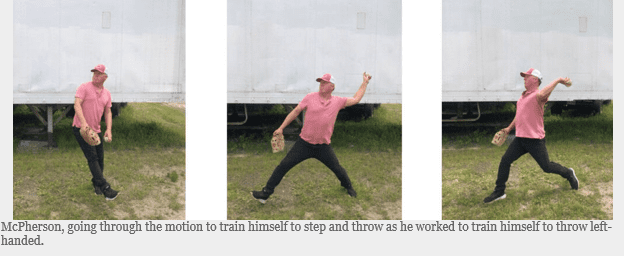
He told me that May 16, 2019, was the date that it all clicked, reflecting on that moment where has able to put both the throw and the step together as one motion. At that moment he said that he knew could do it. That moment was almost four years to the date of this story being written. Each day, Eric made his way outside near the empty 53-foot semi-trailers and used cars for sale on his property, and he utilized a small opening near a field and an area crossing his driveway to create his throwing path. From here, he threw. He threw and threw some more, bouncing baseballs off a cement wall until the balls were destroyed. When a ball was destroyed, he grabbed another one. Day after day he tracked the number of throws he made. He rested his arm when needed and continued practicing stepping with the opposite foot and working to retrain his brain on the process of throwing a baseball.
Think about that for a moment. Think of when you were a kid doing that very same thing learning how to throw a baseball if you can recall it. The awkward arm motions. The stepping with the wrong foot. The bad throws. It was a process at one time or another for each of us who plays the game to develop the skill of throwing. Remember the ball going somewhere other than what your brain thought it was trying to do? At the ripe age of 50 years old, Eric was re-teaching himself how to throw a baseball with his opposite arm.
His process included charting 50 to 100 throws every single day. “Unless there was a downpour outside or it was snowing, I was out throwing against the side of that building,” Eric mentioned. On September 30, 2022, Eric reached over 30,465 throws against that cement wall. To me it’s unimaginable. He threw a baseball against that wall over 30,000 times. That’s crazy! That number has increased way beyond that today as he continues to practice, even though he is now a fully functioning outfielder on our teams as well as other teams in other leagues that he plays on. At the beginning of his journey, he thought, “I’m going to do this no matter what.” I asked him if there were down times and he told me that there really were not. He pointed out that because he is hard-headed, he had his mind made up immediately. He was determined to make this work.
Eric continued to recall his journey, “I threw against that wall over and over again, every day. Man, I threw it a lot! And I remember the day about 2 months in that I knew I could do this. Fast forward about another 6 months and one of my workers put on a glove and we went out to play catch. He looked at me and said, ‘Holy shit, you actually threw the ball right to me!’ He was surprised that I could not only throw it left-handed but that I could throw it accurately. That really helped my confidence grow. As I said, I knew I could do this.”
A short time later, Eric purchased a radar gun. He understood he wasn’t going to pop the mitt anytime soon. This wasn’t an ego thing. He wanted to know how hard he could throw. He wanted to know if he measured up to others who can throw well or even hard. Could he compete with others at a normal or even higher level? He felt he needed to track his progress. The first time he clocked himself he was throwing around 40 miles per hour.
“Right now, I can throw 55 miles per hour, and that’s really disappointing,” McPherson continued. I chuckled at his remark, and he asked me why I was laughing. The truth is, that there are pitchers in our league that do not throw that fast. We all have faced a guy or two that arcs it over the plate. As his friend and as someone being honest, 55 miles per hour is pretty solid when you play catch with him. He can bring it well enough that if you don’t really notice him going through the process of the new throwing motion, to most he would appear to be throwing a baseball somewhat normal for a guy 50 years plus years of age. “I’ll be happy if I can get up to 60,” he said. In the last six months, he hasn’t practiced throwing as much as he used to, but he’s now playing more than he was before, so that is where his practice comes in.
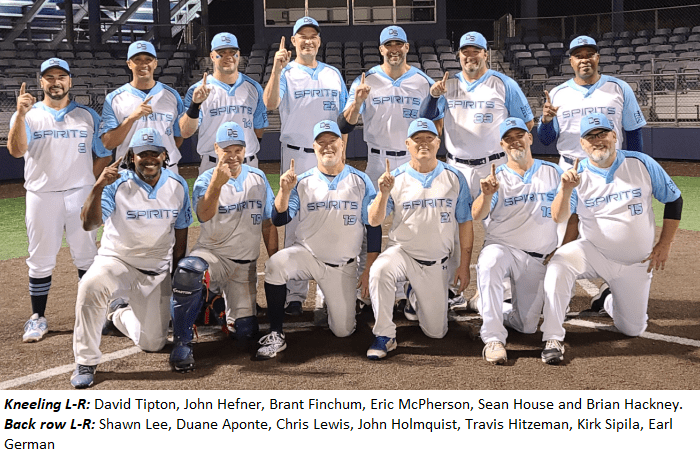
“David Tipton and Ryan Marsland, both put me in my place though,” McPherson muttered as he was reflecting on a pair of our teammates with great arms in the outfield. “Man! When I watch them throw with a flip of their wrists, I’m so jealous.”
It’s obvious Eric misses throwing the ball hard like he used to. And if you were able to see our teammates in action, you would understand why he misses it. Both players being referred to are hard-throwing outfielders that can gun a person down from any spot on the field; a couple of guys on our ball club with ‘guns’ for arms. Anybody who has ever played in the outfield envies a guy with a gun for an arm in the outfield. “My initial goal was just to be able to throw the ball to second base from the outfield,” Eric continued.
He may be hard-headed, but he is also humbled too. The fact is, he can get the ball in well enough. Ultimately, Eric wants to move back to the infield, and he indicates that he wants to play third base as Don Mattingly did.
“I was a really good infielder,” he said. “Outfield is hard. It requires a completely different understanding, especially chasing balls that tail on the ball moving away from you. I remember my first catch when I started playing outfield left-handed. I have played infield, caught, and pitched all my life. I never played in the outfield. Next thing I know, I’m chasing down a ball tailing away from me in left field. I slid and I actually made the catch. That moment also helped me build confidence.”
That part of our conversation got me into discussing the other part of this process he had to go through; learning to catch with your opposite hand. Think about it if you were in his shoes. Your former throwing hand is now your catching hand. Outside of learning to throw opposite handed, you now have to erase years of muscle memory and instinct to now learn how to roll your hand, cover your face, pick a grounder or a hop…the more you think about this process, it’s really crazy to think how far Eric has come past the age of 50 to essentially erase what he’s learned to train his brain to do it on opposite hands.
Eric also noted the contrary to making the catch. “There’s been a few times where I thought I had a fly ball easily and I completely missed it. I’m still learning. The outfield is way more difficult than I thought it would be. You have to teach yourself angles and what place to be in to stop or catch the ball. I felt like I was a really good infielder. I had that natural skill set. Being an outfielder is different. I have to get used to it.”
I asked him how he found the motivation and how he felt from when he started to where he is now. “Honestly, I’ve always been a little bit cocky. That’s helped me stay motivated. I wouldn’t have tried this if I wasn’t. I am my own worst critic, and I am self-motivated to be successful.”
Do you miss throwing right-handed, I asked. “That’s a dumb question,” he responded. He was right. I was just curious how it weighed in on his motivation, which must be obviously difficult for a guy that easily threw the mid-70s or touched 80 when he was in a groove. “I do miss playing shortstop and catching. I was really good at those positions,” he continued.
I asked Eric about his goals now that he can throw left-handed, and before I could finish my sentence he quickly replied, “I want to throw harder. I want to throw harder and farther. That’s my main thing.”
I asked him what advice he would give to someone else attempting to throw with their opposite arm; someone who had had surgery or bad news. He told me, “Let’s get to that in a minute. First, let’s face it. All of us guys here,” referring to his teammates,” we don’t have a whole lot in common…except baseball. And we share that 2 or 3 times per week. I have a lot of friends that I grew up with but they’re not people I hang out with anymore. If I can’t play baseball, I don’t get to see Shawn, Kirk, or Finch anymore.” It was obvious that it truly bothered him that he wouldn’t be able to see his teammates on a weekly basis. When he made that point, I reminded him of the night he told me he couldn’t play with us anymore. I told him that he looked like he was really upset when he shared that information, and I explained that I could tell it was eating him up. I’ll never forget when he said, “I can’t play anymore man. I’m done.” The feeling of a potential divorce was mutual. We didn’t want to lose Eric’s personality. He’s a great player, but his presence in the dugout and on the field mattered as well.
Click HERE to view a video of Eric warming up before a recent game
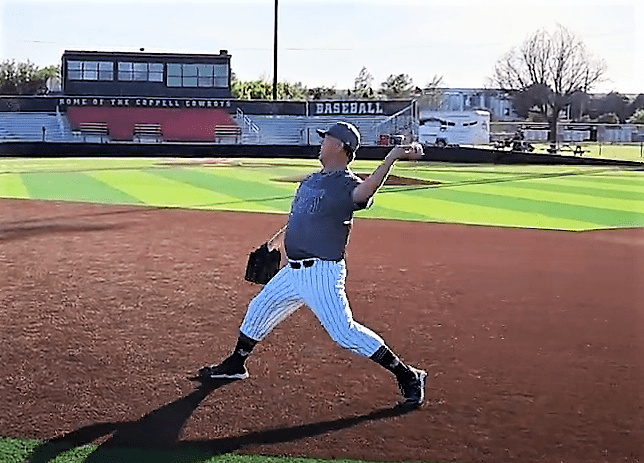
I again asked Eric what would he say to someone else attempting this challenge. “It’s way harder than you think it is,” he replied.” I know I didn’t want to quit. I know that I didn’t want to stop hanging out with you guys, so I kept at it. I know a lot of other guys that quit playing due to injury. That wasn’t going to be me. Not getting to play is one thing, but not hanging out with you guys anymore; I wasn’t going to do that. So, the way I see it I really had no choice. I’ve thrown at that cement wall so much that there are chips and chunks missing form it. I built a small wooden mound to push off of while throwing, not that I want to pitch, but it was something that kept me interested.”
As it turns out, this wasn’t his first stint at working a baseball against a cement wall. As a child, McPherson lived next to his school. He used to wear everybody out in his neighborhood with wiffleball or baseball, so he would have to create his own game and play solo. He would head over to the school and go through nine-inning games in his mind while throwing against that wall. Like most of us in the driveway, yard, or park nearby, he used his imagination to play in games as a kid, practicing throws against the school’s cinder brick wall and essentially paving a path for something he would need to do over 40 years later.
His workout has also evolved into some long toss against the wall, as he works on his speed and his accuracy, which has gotten very good. He continues to work out several times per week and charts his throws each time he does. He laughs about how customers roll up to his shop and ask him what he’s doing. He lets them know that he’s teaching himself how to throw left-handed. His customers have a laugh over it but don’t realize the true depth of his journey to becoming an effective left-handed throwing amateur baseball player.
As he finished up telling me his story, he recalls that for the most part when he started, he was out there throwing without a glove because he didn’t own a left-handed glove. He was having a conversation with his mom and as it turns out, his stepfather was a lefty. His stepfather mailed him his old left-handed glove and Eric continues to use that glove to practice while throwing against the cement wall. He eventually moved on to purchase a used glove to play with during games, but he enjoys using his stepfather’s glove to work out with. As we wrapped up finalizing his story for me to share with all of you, he wanted everyone to know one thing; quitting is permanent.
